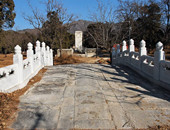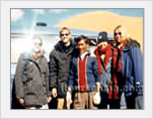
The Ming Tombs (Qing Tomb)
- Travel to The Ming Tombs (Qing Tomb) Emperor Guangzong – Zhu Changluo, was the 14th emperor of the Ming Dynasty, eldest son of Zhu Yijun. Born in 1582 (10th year of Emperor Wanli), he was made crown prince in 1601 (29th year of Wanli). He came to the throne in 1620 (the first day of the eighth month, 48th year of Wanli). He passed away on September 1st on the lunar calendar in the Palace of Heavenly Purity at the age of 39, with a posthumous title of “Emperor Zhen”. He was buried in the Qingling Tomb in 1621 (the ninth month of the first year of Tianqi). Buried together with him were Empresses Guoshi, Wangshi and Liushi. In the 8th month of 48th year of Wanli, Zhu Youjian changed the reign title to the first year of Taichang.
Emperor Guangzong – Zhu Changluo, was the 14th emperor of the Ming Dynasty, eldest son of Zhu Yijun. Born in 1582 (10th year of Emperor Wanli), he was made crown prince in 1601 (29th year of Wanli). He came to the throne in 1620 (the first day of the eighth month, 48th year of Wanli). He passed away on September 1st on the lunar calendar in the Palace of Heavenly Purity at the age of 39, with a posthumous title of “Emperor Zhen”. He was buried in the Qingling Tomb in 1621 (the ninth month of the first year of Tianqi). Buried together with him were Empresses Guoshi, Wangshi and Liushi. In the 8th month of 48th year of Wanli, Zhu Youjian changed the reign title to the first year of Taichang.
 Emperor Zhu Changluo had died suddenly. There was no tomb built for him at the time. People suggested using the abandoned tomb of Zhu Qiyu – “Jingtai low-lying land”. In 1456 (the 2nd month of 7th year of Ming Jingtai), Empress Hangshi of Emperor Jingtai died. The emperor ordered eunuch Cao Jixiang and others to build a tomb. The tomb was completed in the 6th month of the same year and the empress was buried inside. In 1457 (the first month of the first year of Tianshun), Emperor Zhu Qizhen staged a comeback. Zhu Qiyu was demoted as prince Cheng. On the 29th of the 2nd month the same year, Prince Cheng became seriously ill and he died several days later. Zhu Qiyu (Jingtai) was buried in the Jinshan Mountain, in the west suburb of Beijing, as a prince. In the third of month of the first year of Tianshun, Emperor Yingzong (Zhu Qizhen) ordered the minister of the Board of Workers to lead over 5,000 officers and soldiers in charge of protecting the tombs in dismantling the Jingtai Tomb. There was no record whether the coffin of Empress Hangshi was moved to the Jinshan Mountain or left in the wilderness, Since then rats ran amuck and the tomb are became overgrown with brambles. It was a scene of desolation. People called it “Jingtai low-lying land”.
Emperor Zhu Changluo had died suddenly. There was no tomb built for him at the time. People suggested using the abandoned tomb of Zhu Qiyu – “Jingtai low-lying land”. In 1456 (the 2nd month of 7th year of Ming Jingtai), Empress Hangshi of Emperor Jingtai died. The emperor ordered eunuch Cao Jixiang and others to build a tomb. The tomb was completed in the 6th month of the same year and the empress was buried inside. In 1457 (the first month of the first year of Tianshun), Emperor Zhu Qizhen staged a comeback. Zhu Qiyu was demoted as prince Cheng. On the 29th of the 2nd month the same year, Prince Cheng became seriously ill and he died several days later. Zhu Qiyu (Jingtai) was buried in the Jinshan Mountain, in the west suburb of Beijing, as a prince. In the third of month of the first year of Tianshun, Emperor Yingzong (Zhu Qizhen) ordered the minister of the Board of Workers to lead over 5,000 officers and soldiers in charge of protecting the tombs in dismantling the Jingtai Tomb. There was no record whether the coffin of Empress Hangshi was moved to the Jinshan Mountain or left in the wilderness, Since then rats ran amuck and the tomb are became overgrown with brambles. It was a scene of desolation. People called it “Jingtai low-lying land”.
Since Jingtai low-dying land was such a desolate place, 160 years had passed from the Jingtai period to the first year of Taichang and whether the auspicious place could be used was a problem. After repeated surveys and consideration in the Heavenly Longevity Mountain area, Jingtai low-dying land was still the ideal place. There just was no match for Jingtai low-lying land. Finally they discovered five-colored earth when digging a pit at the Jingtai Tomb. This testified that Jingtai low-dying land was still an auspicious place. In 1621, the third month of the first year of Tianqi, the construction of Qingling began and was completed in the 7th month. Emperor Guangzong was buried inside in the ninth month. The tomb was named “Qingling”. The Underground Palace of Qingling was exquisite and entirely made of stone. 1.5 million taels of silver were spent on the tomb.
The Ming Tombs (Qing Tomb) Tour
More ToursYour Question & Quick Answer*Design Your Own Trip
Beijing Top Attractions
Beijing Travel Information
Our Service
Booking Procedures | Terms & Conditions | Payment Methods | Links | Site Map | About Us | Contact Us | Travel Agent
Copyright 2008, All rights reserved.. itourbeijing.com professional Beijing tour operator and China travel service
TEL: 86-10-85711972 (Universal) 1-888-288-9328 (North America) E-mail: contact@itourbeijng.com
Tours Index | China Tours | Beijing Tours | Xi'an Tours | Shanghai Tours | Guilin Tours | Tibet Tours
China Travel | Beijing Travel | Shanghai Travel | Xi'an Travel | Guilin Travel |The Great Wall Tours
China Golf | Beijing Golf | Shanghai Golf | Xiamen Golf | Beijing Map | Beijing Side Trip | Yangtze Cruise | Travel Picture



